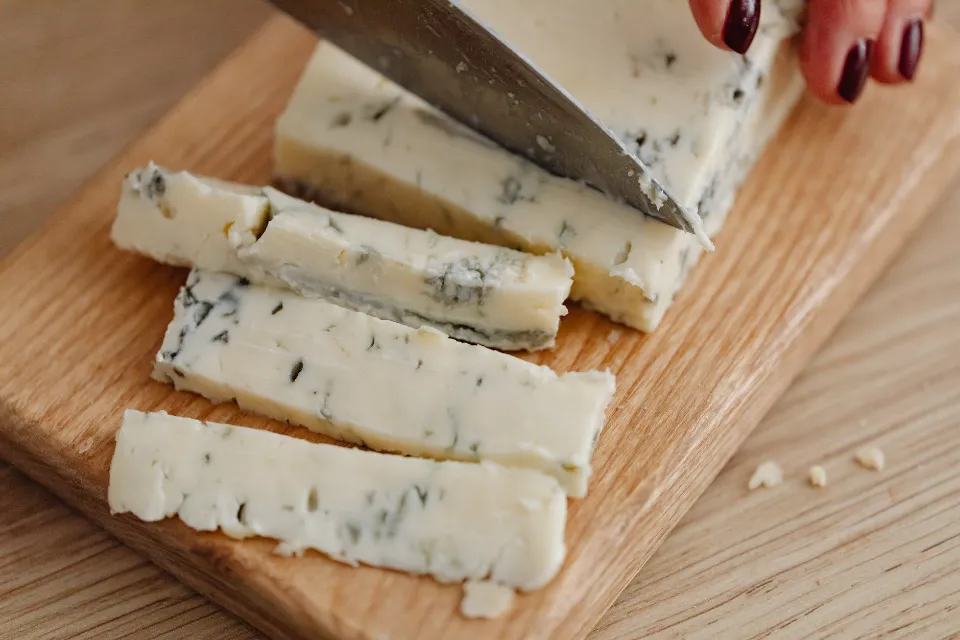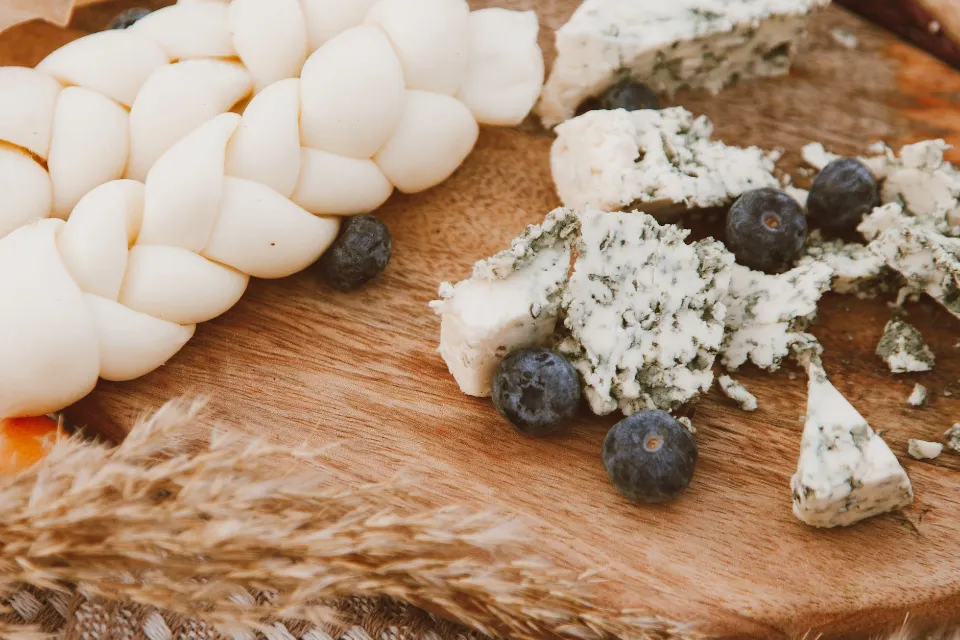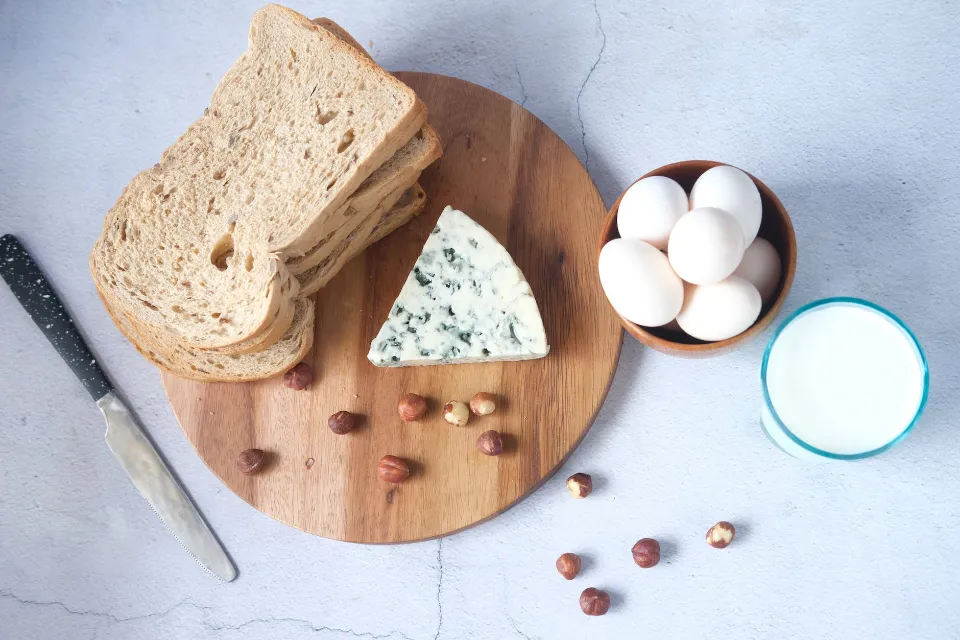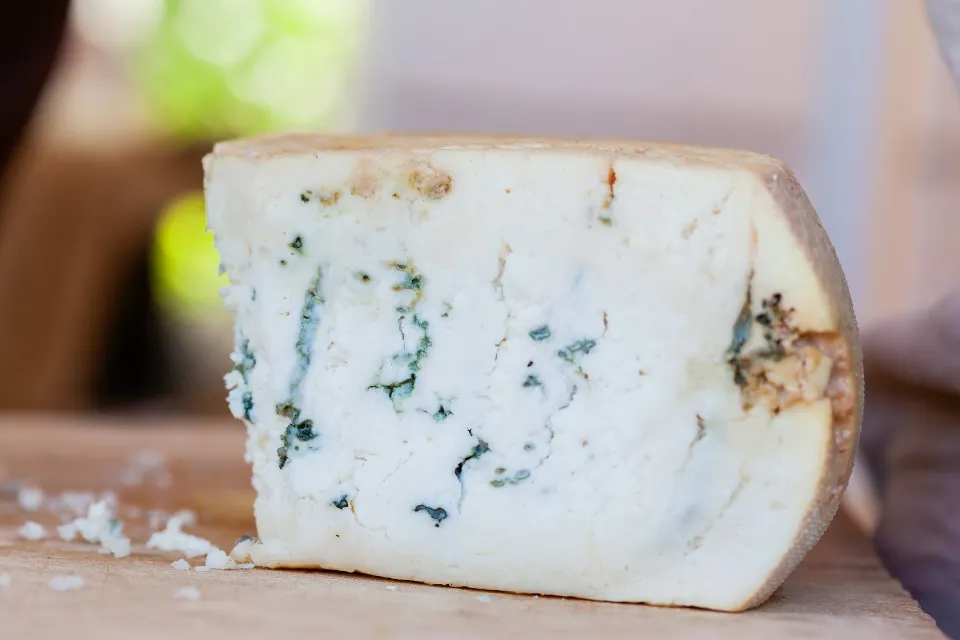Both gorgonzola and blue cheese are familiar to us. But what’s the difference between them? Can we use one to substitute the other?
Gorgonzola is a type of blue cheese made from cow’s milk. But it has a mild flavor unlike other blue cheese. Also it has a softer texture than regular blue cheese.
Curious to know more? No problem! Keep reading and I’ll give you all the information you want to know.

What is Blue Cheese
We use the general term “blue cheese” to describe cheese that has blue mold veins. This particular cheese is produced using pasteurized cow, goat, or sheep’s milk and is allowed to ripen using cultures of the mold Penicillium. Different types of blue cheese typically come from France and Italy, but they later spread throughout the Western world. There are numerous types of blue cheese. Among these varieties are Roquefort, Blue Stilton, Danablu, and Gorgonzola. The flavor and texture may vary depending on the variety, but they typically have a salty, sharp flavor and a pungent aroma. The presence of blue, green, grey, or black mold veins running throughout the cheese is what distinguishes all of these varieties from one another. Additionally, their rinds are edible. While being a good source of calcium, phosphorous, and proteins, blue cheese typically has a high sodium content.
What is Gorgonzola
Italian cheese with bluish-green veins and a robust, rich flavor is called gorgonzola. Blue cheeses include gorgonzola. It’s actually one of the world’s oldest varieties of blue cheese. The name “gorgonzola” comes from the fact that most of its production takes place in the northern Italian region of Gorgonzola. Cow’s milk that has not been skimmed is used to make this cheese. This cheese can be eaten in a variety of ways, and it pairs well with wines like Sauternes, Zinfandel, and Bordeaux Blend (Red).
Gorgonzola has a nutty aroma and a soft, crumbly texture. Its flavor can range from mild to sharp, depending on its age. Aged gorgonzola is stronger, earthier, and has a more pungent bite than young gorgonzola, which is creamy, buttery, and soft with hints of sharp blue. The normal maturation period for this cheese is 3 to 4 months, or., to reach full ripeness. Gorgonzola comes in two different varieties: Gorgonzola Dolce and Gorgonzola Piccante, depending on how old it is. Gorgonzola Piccante is also known as Gorgonzola Montagna, Mountain Gorgonzola, or Gorgonzola Naturale.

Gorgonzola Vs. Blue Cheese Similarities
- Whether it is Gorgonzola or blue cheese, both have the same almost appearances with blue veins
- Both are made from penicillium Glaucum mold and the animal’s milk
- Both varieties of cheese are high in protein, as well as having some sodium and unsaturated fats.
- Calories in gorgonzola cheese are 100 per ounce, similar to the calories in blue cheese
Eight Key Differences Between Gorgonzola Vs. Blue Cheese
When contrasting Gorgonzola and, there are several differences. Bleu cheese
| Components | Gorgonzola | Blue cheese |
|---|---|---|
| History | The first batch of gorgonzola was created in 879 AD in the Italian region of the same name. The blue-green veins were formed in the 11th century. | In the early Middle Ages, blue cheese was unintentionally discovered in a cave. The most popular blue cheese variety, roquefort, was developed in 1070 AD. |
| Origin | Gorgonzola was first made in Italy | Blue cheese was first found in France |
| Made from | Gorgonzola cheese can only be made from unskimmed cow’s milk | Blue cheese can be made from raw milk of cow, goat, and sheep |
| Manufacturing process | Aged for 3-4 months with metal rods and penicillium Glaucum mold in a cave | Aged with penicillium Glaucum mold for 2-3 months in a temperature-controlled environment |
| Culinary Applications | Used in melting topping for burgers, pizza, fruit, pasta, and risotto | Used as a dip, dressing, or spread with sandwiches, crackers, burgers, fruits, and nuts |
| Nutrition Content | 1 ounce of Gorgonzola contains 1g carbs, 6g protein, 9g fats, and 375mg of sodium | 1 ounce of blue cheese contains 8.1g of fats, 0.7g of carbs, 6g of protein, and 5.3g of saturated fats |
| Appearance | White Gorgonzola cheese has green-blue veins running through it. | Blue cheese has spots or strips of blue, blue-green, or blue-gray molds |
| Taste | Mild in taste as compared to other blue cheese varieties with a nutty note | Blue cheese has a sharp and salty taste |

Gorgonzola Versus Blue Cheese Pros and Cons
Pros of Blue Cheese
- The addition of blue cheese to the diet can help in lowering the risk of cardiovascular diseases
- Blue cheese is a good source of calcium and can increase bone health and reduce the risk of osteoporosis
- It contains various vitamins and minerals that play an important role in the different functions of the body
- People who are not able to drink milk due to lactose can eat blue cheese as it contains milk protein
Cons of Blue Cheese
- Blue cheese can go bad if not stored properly and can cause food poisoning
- It can cause weight gain due to the high calories present in it

Pros of Gorgonzola:
- Gorgonzola is a rich source of B vitamins which can help in improving the nervous system and immunity
- It contains less cholesterol than chicken steak, so it can be a good option to add to the meal with vegetables
- It does not contain gluten, so suitable for those who have lactose intolerance
Cons of Gorgonzola:
- All varieties of blue cheese contain high content of sodium and can increase blood pressure
- Choose gorgonzola cheese over dairy products can be a risk as it contains less calcium as compared to dairy products
Conclusion
Gorgonzola is a type of blue cheese. The main difference between blue cheese and gorgonzola is that gorgonzola is milder in taste and softer in texture than other regular blue cheese.
Related Reading
What Types of Cheese Are Good for Weight Losing
Ricotta vs. Cottage Cheese: What Is the Difference in Use
Best Low-Sodium Cheeses You Can’t Miss
FAQs
Are Gorgonzola and Blue Cheese the Same?
Gorgonzola is a type of blue cheese, and blue cheese is a type of cheese with blue veins. Gorgonzola is different from blue cheese in taste, smell, usage, and origin.
What Cheese Is Closest to Gorgonzola?
Many different varieties can be used to replace Gorgonzola, like Roquefort, Blue d’Auvergne, and stilton cheese.
Can You Substitute Blue Cheese for Gorgonzola Cheese?
Yes, as it is also a type of blue cheese, it can be replaced with other blue cheese varieties. Bleu d’Auvergne is the best substitute for Gorgonzola among all the blue cheese varieties.


